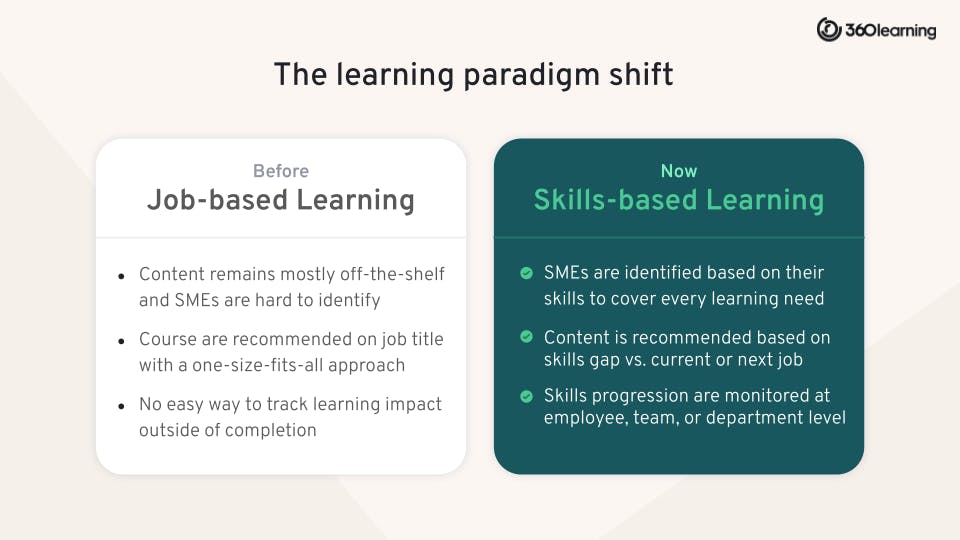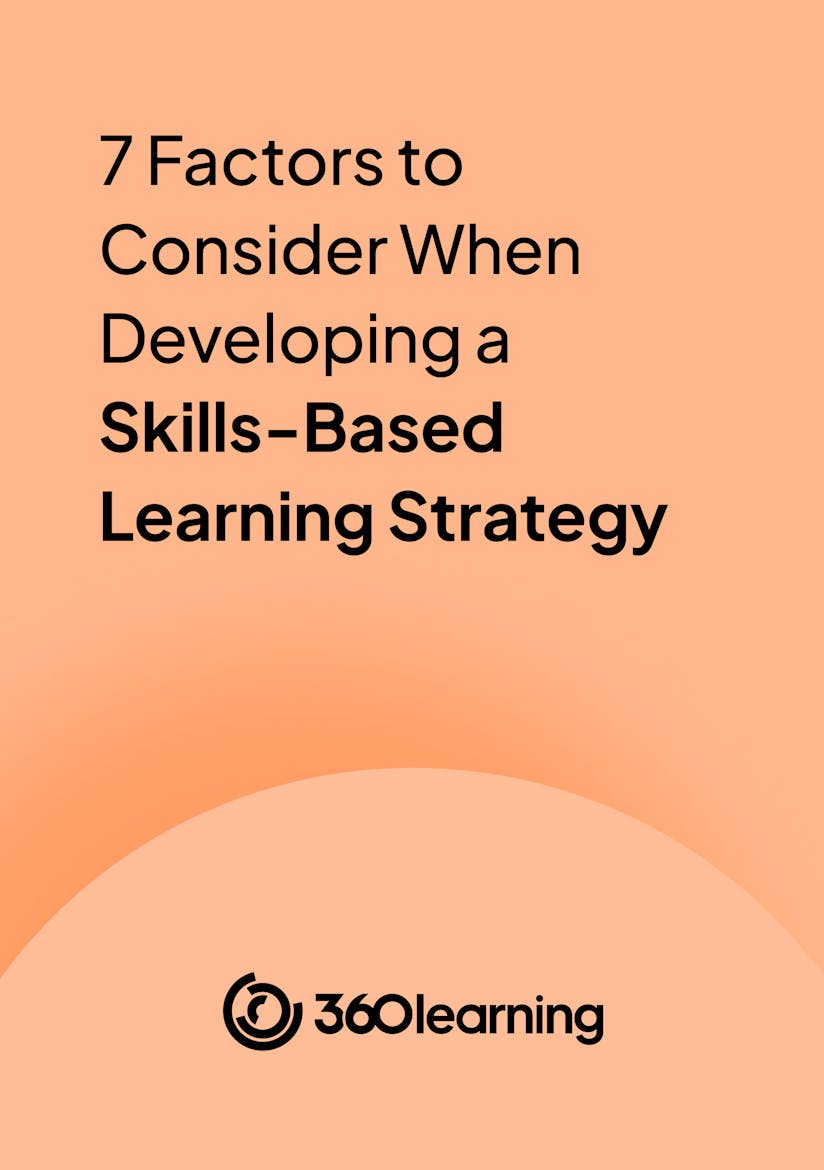Chapter 3: Skills-Based Learning Solutions Are Closing Skills Gaps Faster Than Ever
For many of the talent teams we surveyed, it’s clear that finding enough new hires with the required skills is a challenge, and in fact, often the talent doesn’t even exist on the market. For instance, automakers and battery companies are struggling to hire the right talent to make the shift to electric cars a reality, as the engineering talent pool isn’t large enough.
As a result, L&D teams need to focus their efforts on sourcing, upskilling, and reskilling from within. So, how can you make the transition? The answer lies in deconstructing traditional job roles and moving towards a skills-based model.
What is a skills-based organization?
Deloitte's recent report introduces the concept of skills-based organizations. In these organizations, employees apply their skills to various projects, unburdened by rigid job descriptions. This shift fosters agility in an evolving market, grants agency over business performance, and promotes an equitable work environment.

Why should we care about skills now?
Today’s rapidly evolving skills landscape demands adaptability from both employees and organizations. As LinkedIn’s CEO puts it, “your job is most likely changing around you.” But to make the shift to a skills-based model, organizations need to understand when and where specific skills are required.
Up until now, it’s been difficult to achieve this due to skills mapping being a time-consuming, complex, and costly process, often rendering skills ontologies outdated before they’re even shipped. But with the introduction of the right AI tool, this process can now be made a lot simpler, enabling you to map skills much faster than before and at a more efficient cost, while also keeping skills continuously updated. More on this later!
So, what part do L&D teams play in skills-based organizations?
Why the L&D function is key in actioning a skills-based strategy
While a skills-based strategy typically falls under the HR or talent function, L&D teams are instrumental in acting on that strategy. After all, having a grasp of the skills in an organization is useless if there is no action plan to upskill and reskill your workforce so you can outperform today and outskill tomorrow. This is where skills-based learning comes in and is where L&D teams can really drive adoption and make a significant impact on business performance.
After all, having a grasp of the skills in an organization is useless if there is no action plan to upskill and reskill your workforce so you can outperform today and outskill tomorrow.
As Kevin M. Yates, L&D Detective explains, “Upskilling and reskilling is directly related to how training and learning measurably impacts human and business performance. I'm excited about a shift in mindset and believe we're headed in the right direction by focusing on L&D as an activator for upskilling and reskilling."
"Upskilling and reskilling is directly related to how training and learning measurably impacts human and business performance. I'm excited about a shift in mindset and believe we're headed in the right direction by focusing on L&D as an activator for upskilling and reskilling." - Kevin M. Yates, L&D Detective
Our survey highlighted that there is an opportunity for L&D teams to become more involved in the skills assessment process. In Germany, the US, and France, only around a third of L&D teams are involved in mapping skills to job roles and implementing upskilling and reskilling strategies. It’s only in the UK that the L&D team is more closely involved, with 50% of respondents saying this team is present.

To bridge this gap, L&D leaders must align their learning strategy with the organization’s skills strategy.
5-Steps to developing a skills-based learning strategy to close skills gaps
As organizations continue to prioritize AI and skills-based talent management, L&D leaders can take these five steps to develop a skills-based learning strategy aligned with the organization's goals.
- Map the skills in your organization: Begin by identifying and mapping the skills within your organization for each role. This step lays the foundation for understanding your employees’ skills levels. Then, you can tag your existing library of learning content to highlight the specific skills you want to develop via each learning experience.
- Identify the skills gaps at the employee level: Highlight skills gaps for each employee, whether in their current role, future role, or a different department. The right learning system will help understand the gap between a learner’s current and future role based on data provided by the learner and by the skills and workforce planning data provided by the L&D and/or talent team alongside an AI-powered tool.
- Partner with subject-matter experts (SMEs) to develop missing content: Collaborate with SMEs is to create relevant and timely upskilling and reskilling programs necessary to develop the skills your business needs to perform today and be ready for tomorrow.
- Use AI-powered recommendations to prescribe content: Use AI-powered learning recommendations to provide tailored training for closing skills gaps. You’ll need a learning experience platform (LXP) that provides AI-powered recommendations natively to do this.
- Measure your impact: Continuously measure the impact of your skills-based learning strategy by tracking key metrics such as completion rates of upskilling and reskilling courses and the percentage of the workforce performing at the expected skill level.
Once you’ve identified your skills gaps, it’s time to decide which ones you’ll focus on first. As Guy Wallace, Performance Analyst and Instructional Architect explains, "Think: Begin with the End in Mind and then the Pareto Principle. What are the most critical skills that should be the focus to start with?" These could be just five or so to begin with.

"Think: Begin with the End in Mind and then the Pareto Principle. What are the most critical skills that should be the focus to start with?" - Guy Wallace, Performance Analyst and Instructional Architect
The right tools for a seamless transition
No matter how robust your implementation plan might be, you’ll still need an AI-powered, skills-based LMS. This tool ensures that skills assessments remain up-to-date, you can identify your workforce’s skills gaps, and find internal experts with the necessary knowledge and skills to partner on course content and learning paths for employees.
Moreover, it provides real-time access to skills data, which is vital for aligning the learning strategy with business objectives. From understanding the skills coverage you have in your organization to having a full view of the skills gaps and learning content you have to fill those areas, this information will be critical in reporting back to the business on the execution of the skills strategy.
Join us to explore skills-based learning in action
For a deeper understanding of skills-based learning in practice, check out our virtual keynote.
Featuring 360Learning CEO Nick Hernandez, CLO David James, and VP of Product Pauline Feray, this event will delve into how to map, measure, and close skills gaps with AI. You’ll also get a first-hand look at groundbreaking skills-based learning capabilities developed by 360Learning.

Guarantee a successful move to skills-based L&D
By providing your contact info, you agree to receive communications from 360Learning. You can opt-out at any time. For details, refer to our Privacy Policy.

